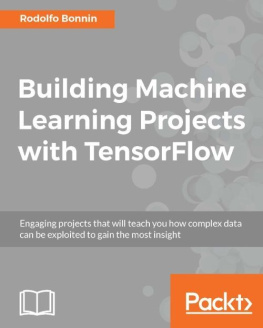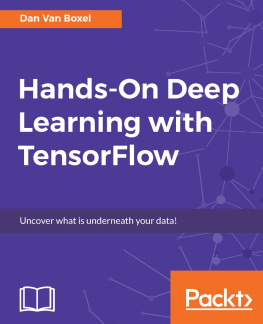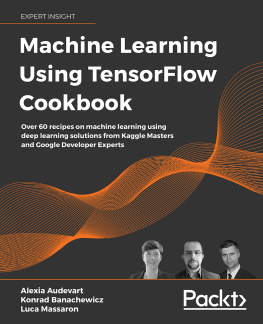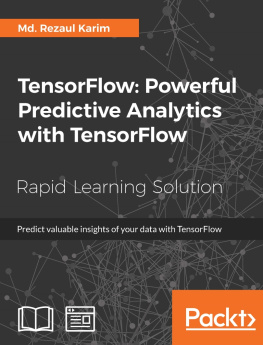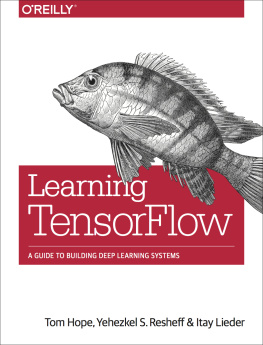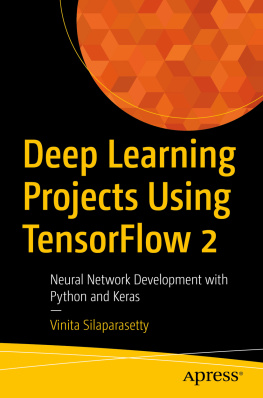Building Machine Learning Projects with TensorFlow
Copyright 2016 Packt Publishing
All rights reserved. No part of this book may be reproduced, stored in a retrieval system, or transmitted in any form or by any means, without the prior written permission of the publisher, except in the case of brief quotations embedded in critical articles or reviews.
Every effort has been made in the preparation of this book to ensure the accuracy of the information presented. However, the information contained in this book is sold without warranty, either express or implied. Neither the author, nor Packt Publishing, and its dealers and distributors will be held liable for any damages caused or alleged to be caused directly or indirectly by this book.
Packt Publishing has endeavored to provide trademark information about all of the companies and products mentioned in this book by the appropriate use of capitals. However, Packt Publishing cannot guarantee the accuracy of this information.
First published: November 2016
Production reference: 1181116
Published by Packt Publishing Ltd.
Livery Place
35 Livery Street
Birmingham
B3 2PB, UK.
ISBN 978-1-78646-658-7
www.packtpub.com
Credits
Author Rodolfo Bonnin | Copy Editor Safis Editing |
Reviewer Niko Gamulin | Project Coordinator Nidhi Joshi |
Commissioning Editor Veena Pagare | Proofreader Safis Editing |
Acquisition Editor Namrata Patil | Indexer Mariammal Chettiyar |
Content Development Editor Siddhesh Salvi | Graphics Disha Haria |
Technical Editor Danish Shaikh Dharmendra Yadav | Production Coordinator Arvindkumar Gupta |
About the Author
Rodolfo Bonnin is a systems engineer and PhD student at Universidad Tecnolgica Nacional, Argentina. He also pursued parallel programming and image understanding postgraduate courses at Uni Stuttgart, Germany.
He has done research on high performance computing since 2005 and began studying and implementing convolutional neural networks in 2008,writing a CPU and GPU - supporting neural network feed forward stage. More recently he's been working in the field of fraud pattern detection with Neural Networks, and is currently working on signal classification using ML techniques.
To my wife and kids and the patience they demonstrated during the writing of this book. Also to the reviewers, who helped give professionalism to this work, and Marcos Boaglio for facilitating equipment to cover the installation chapter. Ad Maiorem Dei Gloriam.
About the Reviewer
Niko Gamulin is a senior software engineer at CloudMondo, a US-based startup, where he develops and implements predictive behavior models for humans and systems. Previously he has developed deep learning models to solve various challenges. He received his PhD in Electrical Engineering from University of Ljubljana in 2015. His research focused on creation of machine learning models for churn prediction.
I would like to thank my wonderful daughter Agata, who inspires me to gain more understanding about the learning process and Ana for being the best wife in the world.
www.PacktPub.com
For support files and downloads related to your book, please visit www.PacktPub.com.
Did you know that Packt offers eBook versions of every book published, with PDF and ePub files available? You can upgrade to the eBook version at www.PacktPub.com and as a print book customer, you are entitled to a discount on the eBook copy. Get in touch with us at service@packtpub.com for more details.
At www.PacktPub.com, you can also read a collection of free technical articles, sign up for a range of free newsletters and receive exclusive discounts and offers on Packt books and eBooks.
https://www.packtpub.com/mapt
Get the most in-demand software skills with Mapt. Mapt gives you full access to all Packt books and video courses, as well as industry-leading tools to help you plan your personal development and advance your career.
Why subscribe?
- Fully searchable across every book published by Packt
- Copy and paste, print, and bookmark content
- On demand and accessible via a web browser
Preface
In recent years, machine learning has changed from a niche technology asset for scientific and theoretical experts to a ubiquitous theme in the day-to-day operations of the majority of the big players in the IT field.
This phenomenon started with the explosion in the volume of available data: During the second half of the 2000s, the advent of many kinds of cheap data capture devices (cellphones with integrated GPS, multi-megapixel cameras, and gravity sensors), and the popularization of new high-dimensional data capture (3D LIDAR and optic systems, the explosion of IOT devices, etc), made it possible to have access to a volume of information never seen before.
Additionally, in the hardware field, the almost visible limits of the Moore law, prompted the development of massive parallel devices, which multiplied the data to be used to train a determined models.
Both advancements in hardware and data availability allowed researchers to apply themselves to revisit the works of pioneers on human vision-based neural network architectures (convolutional neural networks, among others), finding many new problems in which to apply them, thanks to the general availability of data and computation capabilities.
To solve these new kinds of problems, a new interest in creating state-of-the-art machine learning packages was born, with players such as: Keras, Scikyt-learn, Theano, Caffe, and Torch, each one with a particular vision of the way machine learning models should be defined, trained, and executed.
On 9 November 2015, Google entered into the public machine learning arena, deciding to open-source its own machine learning framework, TensorFlow, on which many internal projects were based. This first 0.5 release had a numbers of shortcomings in comparison with others, a number of which were addressed later, specially the possibility of running distributed models.
So this little story brings us to this day, where TensorFlow is one of the main contenders for interested developers, as the number of projects using it as a base increases, improving its importance for the toolbox of any data science practitioner.
In this book, we will implement a wide variety of models using the TensorFlow library, aiming at having a low barrier of entrance and providing a detailed approach to the problem solutions.
What this book covers
, Exploring and Transforming Data , guides the reader in undersanding the main components of a TensorFlow application, and the main data-exploring methods included.

